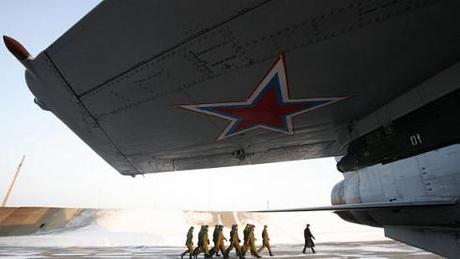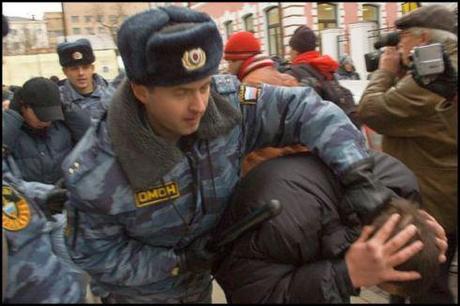The New Great Game Surges Forward
By Sasha / Earth First! News
The NATO draw-down in Afghanistan and pending US strikes against Syria have Russia concerned that its border relations with Central Asia will soon be threatened. With the genuine concern coming from the Left that an attack on Syria would lure Iran into a war, there has been less focus on Iran’s Central Asian neighbors, which are increasingly becoming pawns in a resource scramble between Russia, the US, and China. Enter the New Great Game.
Russia started voicing its concern about US intervention in Syria last year, and recently reinforced its positions in Kyrgyzstan and Tajikistan with military agreements to the tune of more than a billion dollars. Russia’s 700 soldiers based in Kyrgyzstan and 7,000 soldiers in Tajikistan provide an intimidating presence in the region to say the least. Upon returning from the BRICS summit in Durbin this March, as EU-friendly rebels ousted the BRICS-leaning government of François Bozizé in the Central African Republic, Putin ordered military exercises on the Black Sea involving precisely 7,000 troops (along with 20 jets, and 50 pieces of artillery). The maneuvers put to rest questions of Russian battle readiness and capacity to act in the Mediterranean. The gesture was noteworthy: Syria would not be the next Libya; Central Asia would not be the next Central African Republic.

Putin oversees snap military excercise
Even key US strategic thinkers like Zbigniew Brzezinsky have speculated about Imperial motives in Syria. Last month, Brzezinsky stated, “I am struck how eager Great Britain and France appear to be in favor of military action. And I am also mindful of the fact that both of these two powers are former imperialist, colonialist powers in that region… I do not see the context for [military action]. I am concerned that its participants are too narrowly based, that is, it is America and former colonial powers. That seems to me to create a political problem immediately.” In other words, it would seem that the context for military intervention lies in colonial history.
In Which History Repeats
It was the early 19th Century when Syria was to be Napoleon’s entry point for a military intervention into Central Asia. The endgame: a coordinated strike with Russia against British India. Tsar Paul had noted British plans to attack Russia and her allies, the Swedes and Danes, and planned a preemptive intervention through Afghanistan of India, the “crown jewel” of the British Empire. The British registered the move immediately, positioning forces in Afghanistan towards a stalemate fraught with diplomatic intrigue that would involve China in what would become known as the Great Game. The rivalry between Russia and England would end shortly before the onslaught of the First World War, which would see the dissolution of the Ottoman Empire (thanks in no small part to the original Arab Awakening, along with an invasion from the Tsar), as well as the overthrow of the Russian monarchy, itself. The short-lived “Syrian Mandate” following WWI soon evaporated, and Soviet relations in the area would come to have profound influence not only on Syria and Libya, but Central Asia as well.
US forces worked to combat Soviet influence in Afghanistan and Pakistan, and the US-deflected Soviet invasion of Afghanistan is largely seen as the endgame of the Cold War. Russia would be party to the 2003 US invasion of Afghanistan, but grudgingly sat on the sidelines during the NATO invasion of its old ally Libya. After the 9/11/12 attack on the US consulate in Benghazi, head of Russia’s Foreign Affairs Committee Aleksei K. Pushkov exclaimed, “Under Qaddafi they didn’t kill diplomats. Obama and Clinton are in shock? What did they expect—‘Democracy?’ Even bigger surprises await them in Syria.”
Washington did not take the lesson to heart. Instead, the US got into bed with Al Qaeda forces against Assad, bringing ripples of power to militant Islamists in Central Asia—particularly, the Islamic Movement in Uzbekistan, which has an important presence in Tajikistan as well. One seventh of Russia is Muslim, a population largely concentrated in the South, and the Russian government has become increasingly wary (read: oppressive) of Islam in the lead-up to the Winter Olympics in Sochi. Moscow does not take lightly the ballast to radical Islam coming from Syrian rebels supported by Washington.

In June, 300 Muslims were detained in one of several raids on Muslim prayer rooms in Russia
Dangerous Footholds
US hegemony in Central Asia has suffered important losses to Russia in recent years. A couple of months ago, Kyrgyzstan set a deadline for US abandonment of the critical airbase in Manas, a refueling base for fighter jets and stopover point for US troops. The closing of the Manas base is not necessarily Russia’s doing—the US had made itself unpopular through the practice of dumping jet fuel over farmland, not to mention the Pentagon’s no-bid contracts with the regime of the deposed ruler Askar Akaev and his successor, the also-deposed Bakiyev. Bakiyev’s successor, Rosa Otunbayeva, highlighted the problem to the Washington Post: “The corruption is endless. All these dark corners. It is like trying to clean the Augean Stables.”
At the same time, Russian opposition to Manas has never been a secret, and the announcement of a $2 billion aid package to Kyrgyzstan after the decision to begin closing the base in 2009 was redoubled by the switching of Pentagon contracts to a joint Kyrgyz-Russian venture. Russia operates its own airbase in the country, the Kant airbase, which it sees as a vital prophylactic to its interests in the region.
Chinese President Xi Jinping has chosen these escalating tensions to visit Central Asia, and he will soon pay Kyrgyzstan a visit; the “reconstruction of Manas Airport” and a new railway system will surely be on the agenda. China’s entrance into business relations with Krygyzstan over the reclamation of Manas appears to mop up the old US hegemony, which puts both the US and Russia in a somewhat defensive position. Looking at a Kygyzstsan without a US airbase in the region, and with Russian and Chinese air presence is like looking down the wrong side of a barrel for US interests. Yet, the US has an ace up its sleeve in Central Asia.
Uzbekistan remains a close friend to the US military, but not necessarily to US interests. The US maintained an important airbase there until 2005, when Washington criticized the regime for massacring over a hundred protesting civilians. Seen as the most dangerous country in the region, Uzbekistan is a hotbed of human trafficking and child labor (Human Rights Watch calls the country’s record “atrocious”). Yet two visits from Hillary Clinton in 2012 cemented a powerful renewed alliance with the country—so powerful in fact that Uzbekistan subsequently “suspended” its relationship with Russia’s Collective Security Treaty Organization to join NATO. A year later (two months ago), the US downgraded Uzbekistan in human trafficking rank, drawing the ire of human rights activists around the world. A less followed story had the NATO Liaison Officer’s regional office move to Tashkent (capitol of Uzbekistan) from Kazakhstan at the safe time. Corporate contracts in Uzbekistan, however, remain slow in coming. While the Karimov regime does not play ball with the Yankees, China is making inroads.
On Tuesday, Turkmenistan and China signed a bilateral energy agreement; the President’s next destination is Uzbekistan. The commodity turnover between Uzbekistan and China has skyrocked by 60 percent in the first six months of 2013, and Jinping intends to increase engagements in trade as well as political influence. Will China’s competitive edge in Uzbekistan, where US contractors have met with such difficulty, be treated with the same kind of vexation that their presence in pre-coup Mali brought to the French?

(A Tajik cotton field) One thing Jinping and Rahmon (Tajikistan) discussed was an agricultural Free Trade Zone
Tajikistan’s huge natural gas reserves are also on the docket for Jinping’s Central Asian tour. At the same time, China’s ventures in Tajikistan mark a crucial geopolitical position that many do not want to see happen. In a surprising report released in July, the Center for Strategic Studies announced the discovery of “underground games” being carried out to create two new Central Asian states out of shared borders between Tajikistan and Afghanistan. Called Badakhshan and Ferghana Valley, these states are seen by Russia and China as “aimed against, first of all, them” and their interests in the region. Some, including members of Afghanistan’s parliament, think that the breakaway states are the brainchild of the US and UK, which seeks a portion of China’s territory as well (Aga Khan, spiritual leader of Badakhshan, is based in London).
In coming years, this much is certain: the North Atlantic will have a hard go in Central Asia, and Russian diplomacy along with Chinese business has made moves to protect their interests in Central Asia first. Whether or not Putin’s bluff about bombing Saudi Arabia in the event of an airstrike against Syria proves true (it probably won’t), the US will find the same problems that the French did in the early 19th Century if it attempts a Central Asian gambit. If Afghanistan is “the graveyard of empires,” the New Great Game and the hegemonic rivalries therein, may position the next volatile balance of power in the global rush to grab land and resources. With climate change ravaging the region and Islamist as well as more general uprisings increasing in frequency, Central Asia will be a difficult terrain to navigate both politically and economically in the decades to come.
Sasha Ross is a moderator of the Earth First! Newswire, the coordinator of the Earth First! Journal—Cascadia Field Office, and an activist with Bark. His recent writings can be found in continent., The Singapore Review of Books, and Life During Wartime (AK Press 2013). He is also the editor of the forthcoming anthology, Grabbing Back: Resistance Against the Global Land Grab (AK Press 2014). This article is also being published at Counterpunch.


